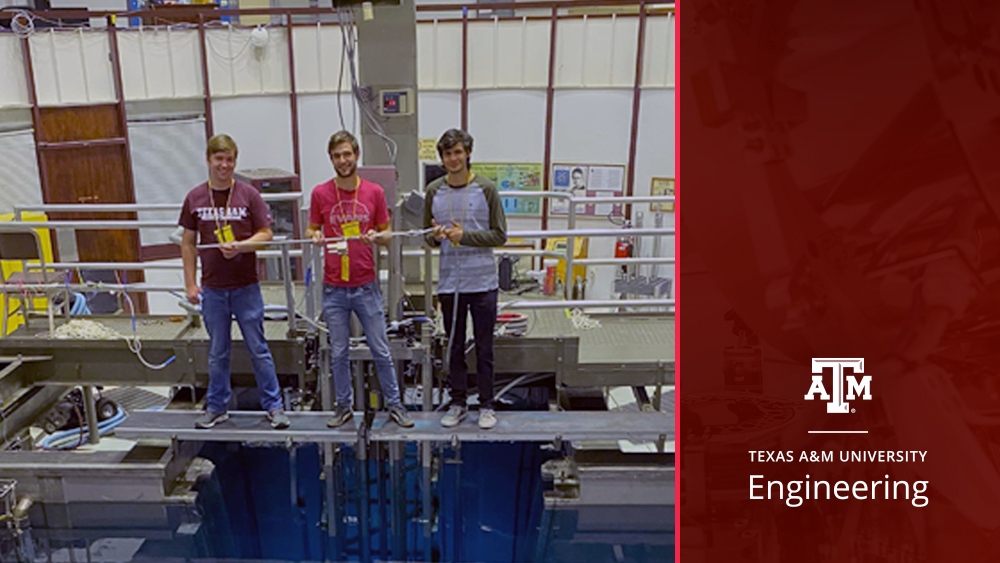
Graduate student Tyler Gates from the Department of Nuclear Engineering at Texas A&M University and Dr. Pavel Tsvetkov, associate professor, are using fiber optics to develop and demonstrate gamma thermometers capable of gathering data in reactors with significantly higher resolutions and accuracy for reactor power measurements at much lower costs than current technologies.
This effort is funded through the Department of Energy’s Nuclear Energy University Programs Office and is a partnership between The Ohio State University and Texas A&M.
Led by Dr. Thomas Blue at Ohio State and his team of students, Blue's team developed and manufactured optical fiber-based gamma thermometers, which Gates applied in his work. The project was made possible with the support of research reactor staff at Ohio State and Texas A&M. Jere Jenkins, Viktor Vlassov and Scott Miller of the Texas A&M Engineering Experiment Station's Nuclear Engineering and Science Center (NESC) also provided resources, such as making the TRIGA® (Training, Research, Isotopes, General Atomics) reactor environment available to successfully demonstrate the gamma thermometer’s capabilities.
These partnerships made it possible to explore using fiber optics for high-fidelity power measurements in current and future nuclear reactors.
“This project is a unique collaboration between universities to develop novel high-resolution power measurement methods leveraging capabilities of both research groups and existing research reactor infrastructure,” said Tsvetkov. “Each school has resources that enable incremental progress to advance comprehensive and novel power-sensing approaches.”
The project has tremendous value for both existing and emerging reactors. Most boiling water reactors today use small fission chambers on the end of a long spool to develop detailed maps of the power distribution in an operating reactor. The fission chambers measure the rate at which neutrons are produced in the core. The sensor moves up and down in the core in about 100 locations. A reading is taken in each location, providing the power from the top to the bottom of the reactor core in each area. However, due to its limited useful lifetime, the sensor can’t be in the core the whole time, meaning it has to be pulled up and down, which can cause potential failure.
Fiber-optic gamma thermometers
Gamma thermometers, like the devices developed for this project, indirectly measure the rate of gamma photon production, which is proportional to the reactor power just like neutron production — by measuring the temperature of a material heated by the gammas. These gamma thermometers are not susceptible to the drift or lifetime limitations that traditional neutron sensors deal with and thus can be fixed in the reactor core rather than moving in and out of the core. Furthermore, optical fibers offer an opportunity to provide spatially continuous measurements along the length of the entire fiber rather than traditional point measurements.
“Boiling water reactors are complicated, large and expensive,” said Gates. “Replacing traditional systems with something small, cheap and simpler could eliminate many current issues. We are attempting to make a fixed in-core system easier to operate while providing additional valuable benefits and optimal data collection.”
To address these issues, the researchers turned to fiber optics, which use flexible, thin fibers to transmit data through fast pulses of light. Using a single fiber, which is the about the thickness of a human hair, fiber optics can do the work of thousands of thermocouples for gamma thermometers.
“With one fiber that is 15 feet long at full assembly, you can measure at every millimeter along that fiber,” said Gates. “With fiber optics, we can achieve a much higher resolution while also making the sensor smaller.”
To test their optical fiber-based gamma thermometer, Ohio State handled building the sensors and the data analytic methodology, and Idaho National Laboratory contributed to the analytical methodology. Gates and Tsvetkov focused on testing the prototype sensors with the help of the NESC, which helped ensure the project's success by providing a reactor to test the new sensors and working with the team to solve some prototype design challenges.
“We were pleased to collaborate with the Ohio State and Texas A&M teams on this set of experiments,” said Jere Jenkins, director of the NESC reactor facilities. “New technology, such as the fiber optic sensors, will enable power plants to obtain additional real-time data that can help maximize the safety and economics of the existing plants. It can also be used in new reactor designs that will come online to help address the planet’s energy needs going forward. We welcome opportunities like these projects and look forward to more collaborations.”
Gates tested three versions of the sensors on Texas A&M’s TRIGA® reactor core under realistic operating conditions. Using this, they were able to use dozens of locations to test the sensors, allowing them to not only characterize the performance of a single sensor but also to characterize the performance of an array of identical sensors and the associated data analysis methods.
Game changer
The optical fiber-based gamma thermometer developed could allow calibration of the power monitors without costly and complicated traversing in-core probe systems.
“Through our various studies, we proved that this technology is viable while also showcasing the benefit of university research reactors,” said Gates. “There are very few other reactors in the world where you could put as many sensors as we did and achieve the measurements that we were capable of without a complete redesign.”
According to Gates, this would be a game changer for existing reactors that desire to optimize their operations and future reactors where simplicity and high-resolution data are not just desired but expected. The work iterates on gamma thermometer design by swapping thermocouples in the gamma thermometer for an optical fiber, which allows greater resolution at a much smaller size.
“Users of advanced reactors are looking at simplifying not only their physical systems but their operations as well,” said Gates. “Our development is the kind of technology that enables that simplification. Our results showed significant promise for developing these sensors into a commercial product, with most challenging issues related to software rather than hardware.”
